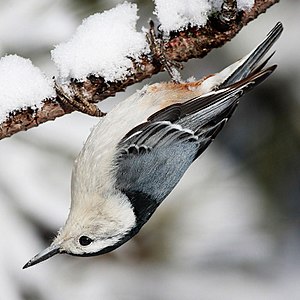Difference between revisions of "Field Guide/Birds/Sitta carolinensis"
From Pathfinder Wiki
(New page: {{Bird id | latin_name = Sitta carolinensis | name = White-breasted Nuthatch | image_1 =Sitta-carolinensis-001.jpg | caption_1 = White-breasted Nuthatch | image_2 = | caption_2 = | image_3...) |
m (6 revisions: re-import from WB, including edit history) |
||
| (5 intermediate revisions by the same user not shown) | |||
| Line 2: | Line 2: | ||
| latin_name = Sitta carolinensis | | latin_name = Sitta carolinensis | ||
| name = White-breasted Nuthatch | | name = White-breasted Nuthatch | ||
| + | | level = 4 | ||
| image_1 =Sitta-carolinensis-001.jpg | | image_1 =Sitta-carolinensis-001.jpg | ||
| caption_1 = White-breasted Nuthatch | | caption_1 = White-breasted Nuthatch | ||
| Line 11: | Line 12: | ||
| description =These birds are permanent residents, sometimes moving south in winter. | | description =These birds are permanent residents, sometimes moving south in winter. | ||
They forage on the trunk and large branches of trees, and are well-known for descending head first, a behavior unique to the white-breasted nuthatch. Their principal diet consists of insects and a few varieties of seeds. They often travel with small mixed flocks in winter. | They forage on the trunk and large branches of trees, and are well-known for descending head first, a behavior unique to the white-breasted nuthatch. Their principal diet consists of insects and a few varieties of seeds. They often travel with small mixed flocks in winter. | ||
| − | | call = | + | | call = White-breasted Nuthatch.ogg |
| − | }} | + | }}<noinclude>[[Category:Adventist Youth Honors Answer Book/Transcluded Modules|{{FULLCHAPTERNAME}}]]</noinclude> |
Latest revision as of 19:14, 5 July 2012
| Sitta carolinensis (White-breasted Nuthatch) | |
|---|---|
| Description | |
| These birds are permanent residents, sometimes moving south in winter.
They forage on the trunk and large branches of trees, and are well-known for descending head first, a behavior unique to the white-breasted nuthatch. Their principal diet consists of insects and a few varieties of seeds. They often travel with small mixed flocks in winter. | |

